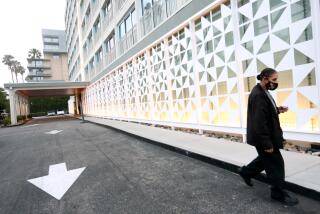Resistant Malibu homeowner finally opens pathway to ‘Billionaires’ Beach’

In the decades-long struggle to make the beaches fronting California’s well-heeled coastal communities more accessible to the public that owns them, a mile-long stretch of Malibu known as Billionaires’ Beach has been the site of a particularly pitched battle.
The enclave is dotted with sumptuous getaways owned by celebrities including former Dodgers owner Jamie McCourt and Larry Ellison, former chief executive of Oracle Corp.
Over the years, movie stars including John Travolta, Courtney Cox and David Arquette have had homes there, and Richard Meier and the late Michael Graves are among the starchitects who have designed residences on the pricey strip officially called Carbon Beach.
Music mogul David Geffen for years fought the California Coastal Commission over access, finally handing over the keys to a walkway that was quickly nicknamed the Hooray for Hollywood Moguls path.
And on Tuesday, the commission will officially announce the opening of another path about a half-mile from the Geffen property.
Activists call it an important victory in the fight between homeowners seeking privacy and people eager to expand their right to walk, run, lie and play on the sand, which is public property up to the average high-tide line.
The debate over the new Carbon Beach trail dates back more than a decade. Access proponents have long wondered why property owner Lisette Ackerberg, who supported many conservation causes, fought so hard to keep people off the public beach in front of the home she and her husband, the late Norman Ackerberg, built on the coveted stretch of coast.
Norman Ackerberg helped start the environmental group Santa Monica Baykeeper, one of the organizations to which he devoted a good portion of the fortune he made as a Minnesota developer.
After he died in 2004 at age 76, Lisette Ackerberg resisted the coastal commission’s push to provide a public pathway to the beach, and the fight became prolonged and peculiar — even for Malibu.
The commission in the 1980s had issued two permits to the Ackerbergs allowing on their beachfront lots the construction of a house, pool, tennis court and sea wall. In exchange, the Ackerbergs agreed to provide a 10-foot-wide “vertical easement.”
The state agency did not take action to open the easement to the public until 2003, when it authorized the nonprofit group Access for All, now defunct, to build and oversee the pathway.
As that group soon learned, the area was blocked by large rocks, a 9-foot-high wall, a concrete slab, a generator, light posts and landscaping that the Ackerbergs had installed. In 2005, the state told Lisette Ackerberg that she had to remove them.
Ackerberg, now 78, resisted, saying the state should force Los Angeles County to build a different pathway that it had already designated about 600 feet to the west at the Malibu Outrigger condo complex. Coastal officials responded that their long-standing policy was to maximize coastal access, not to trade one already identified path for another.
An appellate judge panel agreed that the public was entitled to both paths. The state Supreme Court declined to review the case.
Diane Abbitt, Ackerberg’s attorney, said her client had long felt the state targeted her and applied the law unevenly. “She felt she was in essence being discriminated against,” Abbitt said in a recent interview.
Unbeknown to the state, Ackerberg in 2009 signed an agreement with Access for All. In exchange for a pledge of as much as $250,000 and attorneys fees, Access for All agreed not to build the pathway, but instead to work with Ackerberg to sue the county to open a pathway next to the condos.
Coastal panel officials declined to honor the pact.
In 2013, the commission and Ackerberg finally came to terms. She agreed to pay about $1.1 million and to cover the cost of removing the impediments and building a paved, wheelchair-accessible pathway.
A good chunk of the $1.1 million will go to the Mountains Recreation and Conservation Authority, a government agency that manages public lands for the Santa Monica Mountains Conservancy, to cover the costs of operating and maintaining the easement.
It is the third public access path along Carbon Beach. In addition to the Geffen-adjacent Carbon Beach East walkway, there is the Zonker Harris path at the beach’s western end, near the Malibu Pier. Opened in 1983, it was named for a sun-worshiping character in the “Doonesbury” comic strip.
The Carbon Beach West pathway, as the Ackerberg walk is officially known, is already unlocked from an hour before sunrise to an hour after sunset. On the pathway gate, next to Ackerberg’s big white contemporary house, is a sign reading: Beach Access Open.
Claudio Pinheiro and his wife, Patricia Ferreira, visiting from Brasilia, happened to see it one recent sunny afternoon as they drove by. “We were lucky,” Ferreira, 44, said, adding that the stretch reminded her of exclusive portions of Angra dos Reis, a beach in Brazil.
Meanwhile, the battle to open access to other public beaches in Malibu continues.
In a February letter to the Malibu Outrigger Homeowners Assn., under the authority of a law enacted a year ago, the coastal commission threatened to impose fines of as much as $11,250 per day for each violation.
Stanley Lamport, an attorney for the homeowners group, said the pathway as now delineated runs through a driveway and parking lot and would pose risks to the public. He said the group was negotiating with the Sterling Family Trust, owner of an adjacent parcel, to possibly relocate the easement to that property. Lisa Weinberg, an attorney for the trust, declined to comment.
One of those celebrating the Ackerberg path’s opening was Jenny Price, who helped create the Our Malibu Beaches smartphone app.
Southern California, she said, has a long history of putting the desires of powerful property owners ahead of the public’s right to beach access, so every victory is cause for celebration.
“On one hand, we’re really rejoicing,” she said, quickly adding that her joy was tempered by knowing that each battle over access saps scarce public resources.
martha.groves@latimes.com
Twitter: @MarthaGroves
ALSO:
Is architect Craig Ellwood’s beachfront Hunt House in jeopardy?
Beverly Hills historic homes at risk of demolition, preservationists say
Developer denied extra time to bring Bel-Air mansion into compliance
More to Read
Start your day right
Sign up for Essential California for news, features and recommendations from the L.A. Times and beyond in your inbox six days a week.
You may occasionally receive promotional content from the Los Angeles Times.







